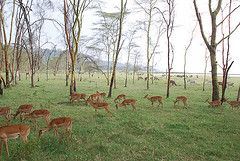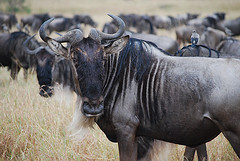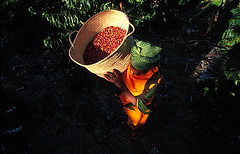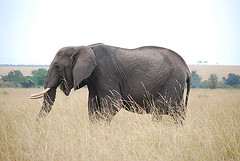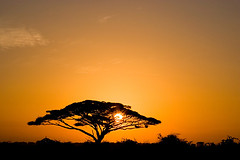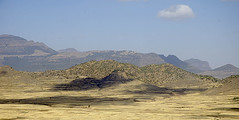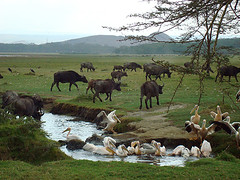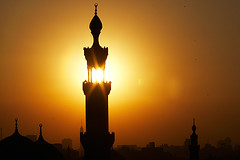Enlightened self-interest demands understanding the issues facing the people of Africa then empowering and supporting African self-initiative to create thier own Renaissance by implementing African solutions to African problems.
Friday, October 19, 2012
Listen to Nehanda Radio Live Zimbabwe
Who is Nehanda Radio?
Nehanda Radio is a Zimbabwean radio station that provides 24 hour running news on the website and during broadcasts. We also aim to provide breaking news as it happens via our popular e-mail alert system which listeners and readers can subscribe to. Zimbabwe is in the midst of a great tragedy and we believe we have a role to play in informing everyone involved in trying to change things.
Why the name
We draw our inspiration from Mbuya Nehanda, the mother of our nation. She was the spirit medium that was the inspiration behind the 1896-97 first chimurenga. When the Europeans arrived in Zimbabwe, Nehanda’s spirit medium was a woman by the name of Nyakasikana. She lived in the northern part of Zimbabwe and used her leadership to spearhead the first war of resistance (Chimurenga CheKutanga) against European domination of the region.
Listen to Nehanda Radio Live
Wednesday, October 3, 2012
Famine In East Africa
With East Africa facing its worst drought in 60 years, affecting more than 11 million people, the United Nations has declared a famine in the region for the first time in a generation. Overcrowded refugee camps in Kenya and Ethiopia are receiving some 3,000 new refugees every day, as families flee from famine-stricken and war-torn areas. The meager food and water that used to support millions in the Horn of Africa is disappearing rapidly, and families strong enough to flee for survival must travel up to a hundred miles, often on foot, hoping to make it to a refugee center, seeking food and aid. Many do not survive the trip. Officials warn that 800,000 children could die of malnutrition across the East African nations of Somalia, Ethiopia, Eritrea, and Kenya. Aid agencies are frustrated by many crippling situations: the slow response of Western governments, local governments and terrorist groups blocking access, terrorist and bandit attacks, and anti-terrorism laws that restrict who the aid groups can deal with -- not to mention the massive scale of the current crisis. Below are a few images from the past several weeks in East Africa.





http://www.theatlantic.com/infocus/2011/07/famine-in-east-africa/100115/
GET A LIFE NOW: Izhar cardboard bike project on Vimeo
Izhar cardboard bike project on Vimeo
ERB provides a full-spectrum of customized financial services for start-up, high-tech, financial, commercial and multi-national clients. For close to two decades our more than 60 strong multi-disciplinary team of management and finance consultants has been providing financial guidance and support to over 300 companies operating in Israel.
The firm has a proven track record for working with and supporting start-up companies and helping them grow. Over the years, ERB has accompanied their clients in raising hundreds of millions of dollars. ERB has also been involved in its clients’ M&A transactions amounting to over one billion dollars. Known for being astute, quick to respond, transparent and professional, clients trust the ERB team to effectively manage the financial aspects of their operations. The advantages are clear: 1) Reducing expenditures by outsourcing financial services; 2) More time for the client to focus on what they do best; and, 3) The peace of mind of knowing that the company’s finances are in good hands.
Izhar cardboard bike project
Contact for the bike: danit@erb.co.il
For more information and content about this project:
erb.co.il/en/aboutus.asp?p=yxdn-vrjd-ufzg-ukyv
ERB in Facebook:
facebook.com/pages/ERB-Financial-Group/108159489328980
ERB in Twitter:
google.com/url?q=https%3A%2F%2Ftwitter.com%2Fdanit92958022&sa=D&sntz=1&usg=AFQjCNETdWvfItdtB1yvRqTSVlER14BQ_Q
Izhar cardboard bike project on Vimeo
GET A LIFE NOW: Izhar cardboard bike project on Vimeo: Izhar cardboard bike project on Vimeo ERB provides a full-spectrum of customized financial services for start-up, high-tech,...
"The How of Happiness" Sonja Lyubomirsky - TalkRational
Daily Mail a daily in England gives away the most important text in the book???
http://www.dailymail.co.uk/pages/you...n_page_id=1908
Quote:
Take these 12 steps to a happier you
By SONJA LYUBOMIRSKY (Taken from the book by DM )» Last updated at 18:21pm on 7th December 2007
STEP 1 - Show gratitude (* There's a lot more to gratitude than saying "thank you." Emerging research shows that people who are consistently grateful are happier, more energetic and hopeful, more forgiving and less materialistic. Gratitude needs to be practised daily because it doesn't necessarily come naturally.)
STEP 2 - Cultivate Optimism
STEP 3 - Avoid overthinking and social comparison
(* Many of us believe that when we feel down we should try to focus inwardly to attain self-insight and find solutions to our problems. But numerous studies have shown that overthinking sustains or worsens sadness.)
STEP 4 - Practice kindness
STEP 5 - Nurture social relationships
STEP 6 - Develop coping skills
STEP 7 - Learn to forgive (* Forgiveness is not the same thing as reconciliation, pardoning or condoning. Nor is it a denial of your own hurt. Forgiveness is a shift in thinking and something that you do for yourself and not for the person who has harmed you. Research confirms that clinging to bitterness or hate harms you more than the object of your hatred. Forgiving people are less likely to be hostile, depressed, anxious or neurotic.
* Forgive yourself for past wrongs. Recognising that you too can be a transgressor will make you more empathetic to others. )
STEP 8 - Find more flow (* "Flow" was a phrase coined by psychologist Mihaly Csikszentmihalyi in the 1960s. It means you are totally immersed in what you are doing and unaware of yourself. Happy people have the capacity to enjoy their lives even when their material conditions are lacking and even when many of their goals have not been reached.)
STEP 9 - Savour the day
STEP 10 - Commit to your goals (* People who strive for something personally significant, whether it's learning a new craft or changing careers, are far happier than those who don't have strong dreams or aspirations. Working towards a goal is more important to wellbeing than its attainment.)
STEP 11 - Take care of your soul (* A growing body of psychological research suggests that religious people are happier, healthier and recover better after traumas than nonreligious people. ...
* Find the sacred in ordinary life ...)
STEP 12 - Take care of your body
"The How of Happiness" Sonja Lyubomirsky - TalkRational
Saturday, September 22, 2012
Africa next: With investment outpacing aid, is this a new golden age for the poorest continent? - The Globe and Mail
Watch
Video: Investigating the Africa boom
In this first of a six-part series, Globe and Mail Africa correspondent Geoffrey York investigates how Africa's growth is changing its future.
In the dusty streets of the tiny village of Romaro, a building boom is under way. Crumbling mud shacks are being replaced by new tin-roofed houses. Almost overnight, the village’s ancient way of life has vanished. Most of its farmland has been swallowed up by a Swiss multinational, Addax Bioenergy, which has leased more than 14,000 hectares of Sierra Leone for a $330-million sugar-cane plantation to produce ethanol for the European market.
In pictures: The faces of development in Sierra Leone
“We get a wage every month,” says Mohamed Kamara, a security guard at the sugar-cane plantation. “Now, I have job security, and I can get credit from a bank. It’s far better than before.”
It's the unexpected message of today's Africa. Every week, another bank or investment fund is touting it as the next big thing, an emerging lion to follow the Asian tigers. Resource exports are soaring, and growth is climbing to unprecedented heights – second only to Asia, and fast catching up. And for the first time in generations, Africa is receiving more investment than foreign aid.
But people tell a different story just a few kilometres away from Romaro, in Lungi Acre. The 700 villagers there have been boxed in by the Swiss project, their huts surrounded by the vast plantation. Rice and cassava fields were bulldozed, and people were left with so little water and farmland that they say they must buy imported rice in the markets. Just outside the village, a water reservoir is fenced off with razor wire, and guards patrol to chase villagers away from the sugar cane.
“Addax is making the situation much worse,” says Abdullah Serry, an elder. “There’s no water for the little land we have left. We were dependent on those lands for all these years. We depended on them for survival. Now, we rely on Addax for everything.”
The dynamic of the two Sierra Leonean villages is the tale of the new African boom.
As investors and traders pour in, some of the poorest corners of the continent are being transformed. “Tomorrow’s Africa is going to be an economic force,” says a report from Goldman Sachs. KPMG trumpets the Africa story as “the rise of the phoenix.”
Many factors have made this possible. After decades of stagnation, in recent years most African countries began to reform their economies. Wars, coups, political instability and disease have declined since the late 1990s. And rising commodity prices have lured investment in African resources.
Mobile technology is leapfrogging ahead (Africa has become one of the fastest-growing markets for Canadian firm Research in Motion’s BlackBerry) and a new consumer class has been born. Multinational retailers are leaping in, and even Wal-Mart recently acquired a chain with nearly 300 stores in 14 African countries.
The prosperity of China has been a particular spark, with about 2,000 Chinese companies investing $32-billion in Africa by the end of 2010. Beijing’s trade with Africa has soared from $2-billion to an incredible $166-billion in the past dozen years.
But what is the truth behind the hype? The Globe and Mail has spent months investigating the African boom, journeying from Congo and Burkina Faso to Liberia and Botswana, talking to everyone from miners and farmers to factory owners and chief executives.
The rise of Africa is an issue with huge ramifications for Canada, since it could affect how we tailor our foreign aid, how our mining and energy companies choose their next targets and where our manufacturers will find their future markets. Yet the realities are obscured by lingering clichés about Africa and an unwillingness to consider the social costs.
As foreign investment mounts, it often brings with it traumatic social dislocation and a distorted economy. The money often disappears into the pockets of a corrupt elite, while ordinary Africans see fewer benefits. Oil-rich countries such as Nigeria and Angola are the most extreme examples, where billions of dollars in oil revenue have gone into the foreign bank accounts of top officials, leaving most of their citizens poorer than ever.
It does not have to be this way. A few African countries, such as Botswana and Ghana, have carefully managed their resource revenue and transformed themselves into middle-income countries. Botswana has capitalized on its diamond mines by creating a fledgling industry in diamond sorting and processing, and it is increasingly seen as a model for the continent.
Africa next: With investment outpacing aid, is this a new golden age for the poorest continent? - The Globe and Mail
Wednesday, September 19, 2012
Small is Beautiful
Wednesday, September 19, 2012
Eco Power Africa - A Mini Power Grid Startup
The GEK gasifier which is designed to consume kilos, not tons of biomass daily. The GEK gasifier is clearly a winner for those who have plenty of biomass lying about, such as lumber sawmills, farmers or food processors. Other entrepreneurs will have to obtain biomass. Since biomass is waste by-product, the main expense will not be the biomass itself but transporting it to the gasifier.A need for decentralized micro-grids:
the solution is modeled on the telecom breakthrough in Africa. Following the central-station model as practiced in the West meant that Africa had no tele–communications for decades. Cellular telephone technology allowed local entrepreneurs to build small, cheap, and rapidly deployable cell towers. Cellular technology enabled Africa to avoid replicating the expensive centralized model.Coupled with biogas generation, mini-grids like these could solve the energy power generation problem.
The same can be done with electricity generation. Instead of investing billions in constructing major power stations, transmission towers, and distribution and metering infrastructure, it is much easier to deploy micro-to-small power generating nodes that will supply electricity efficiently on a localized basis.
By default, power generation in most of Africa is already Distributed Generation. Institutions and individuals that can afford it use diesel genrators. But diesel is much too expensive, inefficient and polluting.
Because there is no readily available distribution network for conventional fossil fuels – gas, oil or coal – distributed generation in Africa will depend on the advent of green technologies.
EcoPower Africa’s solution is to generate electricity with locally available biomass fuel, making electricity much more affordable.
Saturday, September 15, 2012



PERMANENT ERROR
During 2009-2010 Hugo photographed the people and landscape of an expansive dump of obsolete technology in Ghana. The area, on the outskirts of a slum known as Agbogbloshie, is referred to by local inhabitants as Sodom and Gomorrah, a vivid acknowledgment of the profound inhumanity of the place. When Hugo asked the inhabitants what they called the pit where the burning takes place, they repeatedly responded: ‘For this place, we have no name’.
Their response is a reminder of the alien circumstances that are imposed on marginal communities of the world by the West’s obsession with consumption and obsolesce. This wasteland, where people and cattle live on mountains of motherboards, monitors and discarded hard drives, is far removed from the benefits accorded by the unrelenting advances of technology.
The UN Environment Program has stated that Western countries produce around 50 million tons of digital waste every year. In Europe, only 25 percent of this type of waste is collected and effectively recycled. Much of the rest is piled in containers and shipped to developing countries, supposedly to reduce the digital divide, to create jobs and help people.
In reality, the inhabitants of dumps like Agbogbloshie survive largely by burning the electronic devices to extract copper and other metals out of the plastic used in their manufacture. The electronic waste contaminates rivers and lagoons with consequences that are easily imaginable. In 2008 Green Peace took samples of the burnt soil in Agbogbloshie and found high concentrations of lead, mercury, thallium, hydrogen cyanide and PVC.
Notions of time and progress are collapsed in these photographs. There are elements in the images that fast-forward us to an apocalyptic end of the world as we know it, yet the alchemy on this site and the strolling cows recall a pastoral existence that rewinds our minds to a medieval setting. The cycles of history and the lifespan of our technology are both clearly apparent in this cemetery of artifacts from the industrialised world. We are also reminded of the fragility of the information and stories that were stored in the computers which are now just black smoke and melted plastic.
Link: http://www.pieterhugo.com/
PIETER HUGO - Photographer


PERMANENT ERROR
During 2009-2010 Hugo photographed the people and landscape of an expansive dump of obsolete technology in Ghana. The area, on the outskirts of a slum known as Agbogbloshie, is referred to by local inhabitants as Sodom and Gomorrah, a vivid acknowledgment of the profound inhumanity of the place. When Hugo asked the inhabitants what they called the pit where the burning takes place, they repeatedly responded: ‘For this place, we have no name’.
Their response is a reminder of the alien circumstances that are imposed on marginal communities of the world by the West’s obsession with consumption and obsolesce. This wasteland, where people and cattle live on mountains of motherboards, monitors and discarded hard drives, is far removed from the benefits accorded by the unrelenting advances of technology.
The UN Environment Program has stated that Western countries produce around 50 million tons of digital waste every year. In Europe, only 25 percent of this type of waste is collected and effectively recycled. Much of the rest is piled in containers and shipped to developing countries, supposedly to reduce the digital divide, to create jobs and help people. In reality, the inhabitants of dumps like Agbogbloshie survive largely by burning the electronic devices to extract copper and other metals out of the plastic used in their manufacture. The electronic waste contaminates rivers and lagoons with consequences that are easily imaginable. In 2008 Green Peace took samples of the burnt soil in Agbogbloshie and found high concentrations of lead, mercury, thallium, hydrogen cyanide and PVC.
Notions of time and progress are collapsed in these photographs. There are elements in the images that fast-forward us to an apocalyptic end of the world as we know it, yet the alchemy on this site and the strolling cows recall a pastoral existence that rewinds our minds to a medieval setting. The cycles of history and the lifespan of our technology are both clearly apparent in this cemetery of artifacts from the industrialised world. We are also reminded of the fragility of the information and stories that were stored in the computers which are now just black smoke and melted plastic.
PIETER HUGO - Photographer
Link: http://www.pieterhugo.com/
Friday, May 11, 2012
Mali Crisis Worsens West Africa Food Crisis | Special Section | World | Epoch Times
West Africa’s Sahel region is facing a massive food shortage, with as many as 15 million people facing hunger or starvation, a high-level United Nations official said.
The recent clashes between Tuareg-led rebels and the Malian government have worsened the food insecurity in the Sahel region, a belt-like area that stretches across Africa, from the Red Sea to the Atlantic Ocean. Tens of thousands of people have fled Mali to nearby countries such as Niger, where food is in short supply.
“In this case, the crisis is different than it’s ever been in the past,” said Ertharin Cousin, the Executive Director of the World Food Program (WFP), referring to crises in 2005 and 2010. “It’s even more complicated because of the evolving conflict situation in Mali as well as the high food prices,” she said in a press release.
Cousin said around 35,000 refugees have poured into Niger from Mali in the past several months, exacerbating problems caused by a rain shortfall and failed harvest in the region. The lean season, which technically starts in June, has already started for some families.
“Because the rains failed last season, what you’re seeing is that the hungry poor, the most vulnerable populations, are now at the point where they have depleted their assets,” Cousin said.
However, with the political situation in Mali still in flux, the U.N. expects even more people to cross into Niger.
“My father gave me a goat that I sold to pay for transportation from Menaka (in eastern Mali) to Niger, but it was not enough for all of us so I left my three youngest children with my cousins,” Mariama, 47, was quoted as saying by the U.N.
“We could not stay in Menaka as my family members are also having problems to feed their own families; we just did not want to be an extra burden.”
Ousseini, a 30-year-old Malian teacher, said he was forced to sell some goats and a television to get enough money to take himself, his wife, son, and seven nephews to the Mangaize camp in Niger. “We left because of insecurity, but also because I have not been paid since February,” he said.
Around 1 million children risk starving to death in the near future in the Sahel region if the international community idles, the U.N. said.
The Sahel is the transitional point between the Sudanian Savannas in the south and the Sahara desert, and cuts across Senegal, Mauritania, Mali, Burkina Faso, Algeria, Niger, Nigeria, Chad, Cameroon, Sudan including Darfur, and Eritrea.
Related Articles
The Epoch Times publishes in 35 countries and in 19 languages. Subscribe to our e-newsletter.
West Africa’s Sahel region is facing a massive food shortage, with as many as 15 million people facing hunger or starvation, a high-level United Nations official said.
The recent clashes between Tuareg-led rebels and the Malian government have worsened the food insecurity in the Sahel region, a belt-like area that stretches across Africa, from the Red Sea to the Atlantic Ocean. Tens of thousands of people have fled Mali to nearby countries such as Niger, where food is in short supply.
“In this case, the crisis is different than it’s ever been in the past,” said Ertharin Cousin, the Executive Director of the World Food Program (WFP), referring to crises in 2005 and 2010. “It’s even more complicated because of the evolving conflict situation in Mali as well as the high food prices,” she said in a press release.
Cousin said around 35,000 refugees have poured into Niger from Mali in the past several months, exacerbating problems caused by a rain shortfall and failed harvest in the region. The lean season, which technically starts in June, has already started for some families.
“Because the rains failed last season, what you’re seeing is that the hungry poor, the most vulnerable populations, are now at the point where they have depleted their assets,” Cousin said.
However, with the political situation in Mali still in flux, the U.N. expects even more people to cross into Niger.
“My father gave me a goat that I sold to pay for transportation from Menaka (in eastern Mali) to Niger, but it was not enough for all of us so I left my three youngest children with my cousins,” Mariama, 47, was quoted as saying by the U.N.
“We could not stay in Menaka as my family members are also having problems to feed their own families; we just did not want to be an extra burden.”
Ousseini, a 30-year-old Malian teacher, said he was forced to sell some goats and a television to get enough money to take himself, his wife, son, and seven nephews to the Mangaize camp in Niger. “We left because of insecurity, but also because I have not been paid since February,” he said.
Around 1 million children risk starving to death in the near future in the Sahel region if the international community idles, the U.N. said.
The Sahel is the transitional point between the Sudanian Savannas in the south and the Sahara desert, and cuts across Senegal, Mauritania, Mali, Burkina Faso, Algeria, Niger, Nigeria, Chad, Cameroon, Sudan including Darfur, and Eritrea.
Related Articles
The Epoch Times publishes in 35 countries and in 19 languages. Subscribe to our e-newsletter.
Thursday, May 10, 2012
Bid to stop elephant poaching in Cameroon ends in violence - Calling Card News
Bid to stop elephant poaching in Cameroon ends in violence
However, this tactic resulted in violence. A clash between poachers and the Cameroon Rapid Intervention Battalion left 10 elephants, one soldier and one poacher dead.
"The fight against poaching is a war and like any other war there will be casualties," said Celine Sissler Bienvenu, director of IFAW France and head of operations in Africa. "These poachers are working in gangs. We found shells indicating they are armed with military-issue automatic or semi-automatic weapons... Villagers who have come into contact with the poachers were told of their plans to collect as much ivory as they can until the end of March."
The best way to put an end to the unnecessary slaughter of elephants in Cameroon, according to Sissler Bienvenu, is to remove the demand for ivory on an international level.
How to Make a Difference
How to Build a Culture of Community Involvement
Below are a few suggestions to encourage more volunteers to come forward. None of this will result in stampedes of volunteers overnight, but if we think long term about building a community with a culture of active community involvement, they may help.
- Set up service awards presented by Council/Community Board/local government - monthly/annually/as appropriate
- Volunteer "jobs" board in the library and also in the Messenger
* Make sure that listings say skills required, that training is offered, what skills volunteers will gain etc etc - Volunteer "jobs" expo
- Partner with significant employers in the area to have staff community volunteering recognised in some way
- Partner with Government agencies/Social Services to have community service/volunteering encouraged
- Put a monthly volunteer interview/profile in local newsletters/newspapers (+ sponsored award?)
* Why do you volunteer?
* How did you get involved?
* What do you get out of it?
* What skills have you gained?
* What skills did you need?
* How much time does it take?
Interview as diverse range of people as possible - ie not the usual suspects. Eg The bowls club secretary, Lions club treasurer, a volunteer fire fighter, someone from the Marae Committee, a PTA member, the Rugby club Pres ..
How do you encourage Volunteering in your community?
Poachers slaughter 200 elephants in Cameroon national park in six weeks. « The Truth is Where?
A local government official said heavily armed poachers from Chad and Sudan had decimated the elephant population of Bouba Ndjida national park, in Cameroon’s far north.
“We are talking about a very serious case of trans-frontier poaching, involving well-armed poachers with modern weapons from Sudan and Chad who are decimating this wildlife species to make quick money from the international ivory trade,” said Gambo Haman, governor of Cameroon’s northern region.
Speaking on local radio, Haman said some of the poachers were on horseback and operated with the help of the local population, who were given free elephant meat and were glad to be rid of animals that damage their crops.
The International Fund for Animal Welfare (Ifaw) said cross-border poaching was common during the dry season but the scale of the killings so far this year was unprecedented.
“This latest massacre is massive and has no comparison to those of the preceding years,” the group said in a statement.
Citing a record number of large scale ivory seizures in 2011, Traffic, a conservation group that tracks trends in wildlife trading, has warned of a surge in elephant poaching in Africa to meet Asian demand for tusks for use in jewellery and ornaments.
Underlining the clout of the poaching force, Haman said a group of 50 had killed six Chadian soldiers who tried to arrest them as they fled with the ivory.
“In January we counted 146 [elephant] carcasses and since the beginning of this month we’ve had close to 60 already. This may only be a tip of the iceberg as some may have been killed in parts of the park that we cannot access,” Haman added.
Cameroon has dispatched a rapid-reaction force to the area but Haman said there were not enough troops to cover the remote park.
Ifaw said it was not clear how many elephants remained in Cameroon. A 2007 estimate put the figure at between 1,000 and 5,000.
Traffic has said that the spike in poaching and illegal ivory trade in Africa is a direct consequence of China’s investment drive into the continent.
Trans-frontier poaching decimating elephant herds in Camaroon

Poachers, believed to be armed groups from Chad and Sudan, have been blamed for an unprecedented spate of elephant deaths in Bouba Ndjida national park in Cameroon. The demand for ivory in Asia is thought to be the reason for more than 200 elephants being killed within the park in a six-week period.
As a result of this outbreak of poaching by heavily armed gangs, the elephant population within Bouba Ndjida national park in the far north of Cameroon has now been severely depleted- .
“We are talking about a very serious case of trans-frontier poaching, involving well-armed poachers with modern weapons from Sudan and Chad who are decimating this wildlife species to make quick money from the international ivory trade,” says Gambo Haman, governor of Cameroon’s northern region.
Related articles
- Poachers slaughter 200 elephants in Cameroon national park in six weeks. (thetruthiswhere.wordpress.com)
- 200 elephants killed in Cameroon (nation.com.pk)
- Poachers Kill 200 Elephants During Six-Week Spree in Cameroon (scientificamerican.com)
- Poachers kill 200 elephants in Cameroon already this year (gadling.com)
- Poachers kill 200 elephants in Cameroon killing spree (erasmodelavega.wordpress.com)
- Lets poach the poachers....is that allowed in that part of the world? (sunsetdaily.wordpress.com)
- Activists: Poachers kill 200 elephants in Cameroon (seattletimes.nwsource.com)
- Poachers slaughter 200 elephants in Cameroon national park in six weeks (guardian.co.uk)
- At Least 200 Elephants Slaughtered In Poaching Spree (huffingtonpost.com)
Camaroon send in military to stop elephant slaughter | Metro Newspaper
Camaroon send in military to stop elephant slaughter
Written by: Derrick SpiesSustainable Development
http://www.huffingtonpost.com/andrew-muir/balancing-economic-growth_b_1506358.html
Balancing Economic Growth With True Sustainability
Talk here is that Africa's projected growth rate for 2012 will be in excess of 5% and at a time of global uncertainty and general economic downturn. Talking to various delegates it seems that whilst there is a genuine worry around food security and high rates of youth unemployment, there is, at the same time, a renewed optimism about this continent's future.
Wednesday, March 28, 2012
Leymah Gbowee: Unlock the intelligence, passion, greatness of girls - YouTube
Message of Hope
Leymah Gbowee: Unlock the intelligence, passion, greatness of girls - YouTube
by TEDtalksDirector on Mar 28, 2012 http://www.ted.com Nobel Peace Prize winner Leymah Gbowee has two powerful stories to tell -- of her own life's transformation, and of the untapped potential of girls around the world. Can we transform the world by unlocking the greatness of girls?
Sunday, March 18, 2012
Tuesday, February 21, 2012
Timbuktu Chronicles

- Emeka Okafor
- Emeka Okafor is an entrepreneur and venture catalyst who lives in New York City.He is the curator of Maker Faire Africa.He was the director for TED Global 2007 that took place in Arusha,Tanzania.In addition he is a member of the TED fellowship team.His interests include sustainable technologies in the developing world and paradigm breaking technologies in general. His blog, Timbuktu Chronicles seeks to spur dialogue in areas of entrepreneurship, technology and the scientific method as it impacts Africa. "Timbuktu is a city unsullied by the worship of idols...a refuge of scholarly and righteous folk, a haunt of saints and ascetics, and a meeting place of caravans and boats" -Al-Sa'Di
Through a simple processing technique, Demangam Victorine Luekam converts soya milk into a meat-like product. She then fries the soya meat in oil, which it allows it to be stored for up to a week, and sells cubes of it on sticks to a growing number of customers. Martha Chindong, who interviews Demangam, finds that soya meat is tasty as well as nutritious. It’s particularly good for menopausal women, as it contains natural oestrogen hormone. Eating soya products regularly helps to reduce the hot flushes that are a common symptom of menopause. And as a legume crop, soya also boosts soil fertility...[more]
Soyabean image courtesy of Wikipedia
Source:
http://timbuktuchronicles.blogspot.com/
Friday, February 17, 2012
See Africa Differently



Africa is 54 diverse countries filled with people working to bring about positive changes.
Our site is going to showcase exciting news, videos and personal stories from the world's second largest continent.
ONE | Amazing Africa: Photos from our archives
aley/ONE.
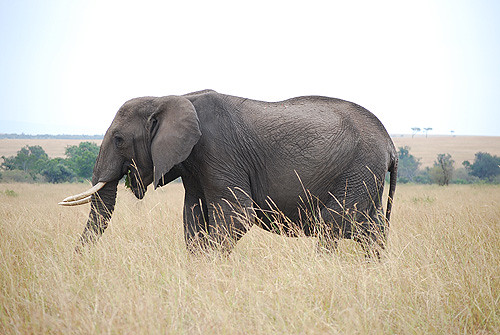
A mighty elephant in Nairobi, Kenya. Photo credit: Maura Daley/ ONE.
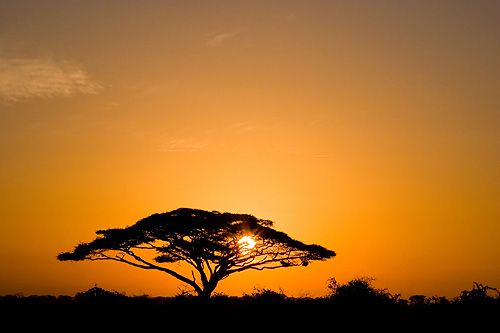
Beautiful african sunrise, with backlit acacia tree on Amboseli Natural Park, Kenya.

View of Kibera from the railroad tracks. Photo credit: Morgana Wingard/ONE.
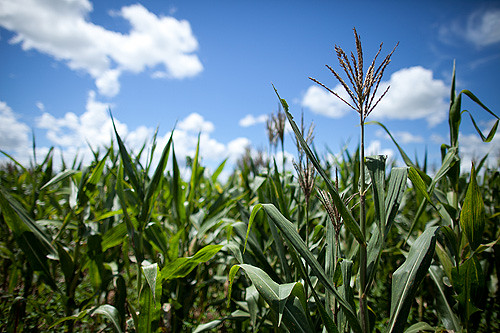
Healthy corn crops growing in Monkey Bay, Malawi. Photo credit: Morgana Wingard/ ONE.
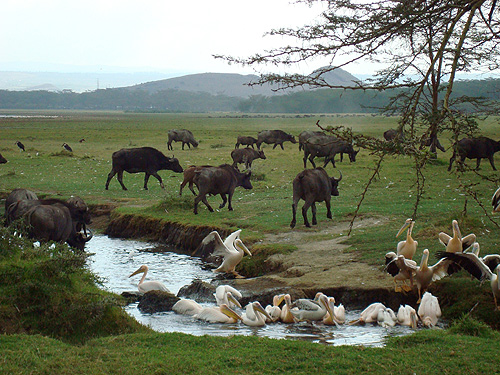
Cows and birds happily coexisting in Kenya.
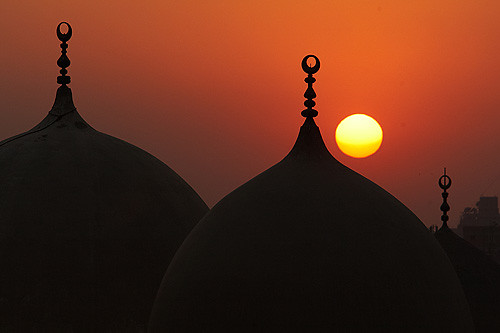
Red dusk in Cairo, Egypt. Photo credit: Olivier Asselin/ Living Proof.

Gorgeous minaret. Photo credit: Olivier Asselin/ Living Proof.
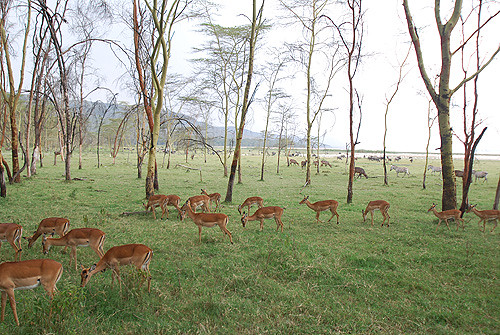
Deer roaming the landscape in Nairobi, Kenya. Photo credit: Maura Daley/ONE.
How did Rwanda cut poverty so much? - latimes.com


How did Rwanda cut poverty so much?
This post has been corrected. See the note at the bottom for details.
The small African nation of Rwanda recently announced that it had cut poverty by 12% in six years, from 57% of its population to 45%. That equals roughly a million Rwandans emerging from poverty -- one of the most stunning drops in the world.
It's a remarkable achievement for Rwanda, which has emerged from civil war and a bloody ethnic genocide in the 1990s. How did it happen? The Times quizzed Paul Collier, director of the Center for the Study of African Economies at Oxford University, about the numbers.
Are there any doubts that the drop is real?
No doubts; I know the economics professor who did the data analysis, and he is highly experienced and painstaking, so it is genuine.
How did Rwanda cut its poverty so much?
There were one or two helpful events, notably the rise in world coffee prices, which pumped money into the rural economy, but, of course, overall the global economy since 2005 has not provided an easy environment for success. Hence, most of the achievement is likely due to domestic policies.
Rwanda is the nearest that Africa gets to an East Asian-style “developmental state,” where the government gets serious about trying to grow the economy and where the president runs a tight ship within government built on performance rather than




